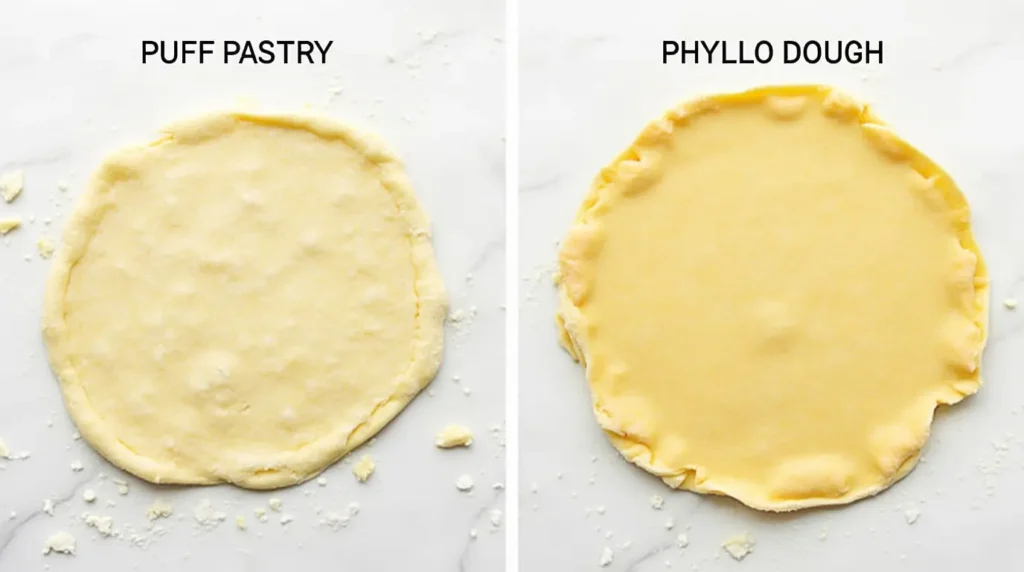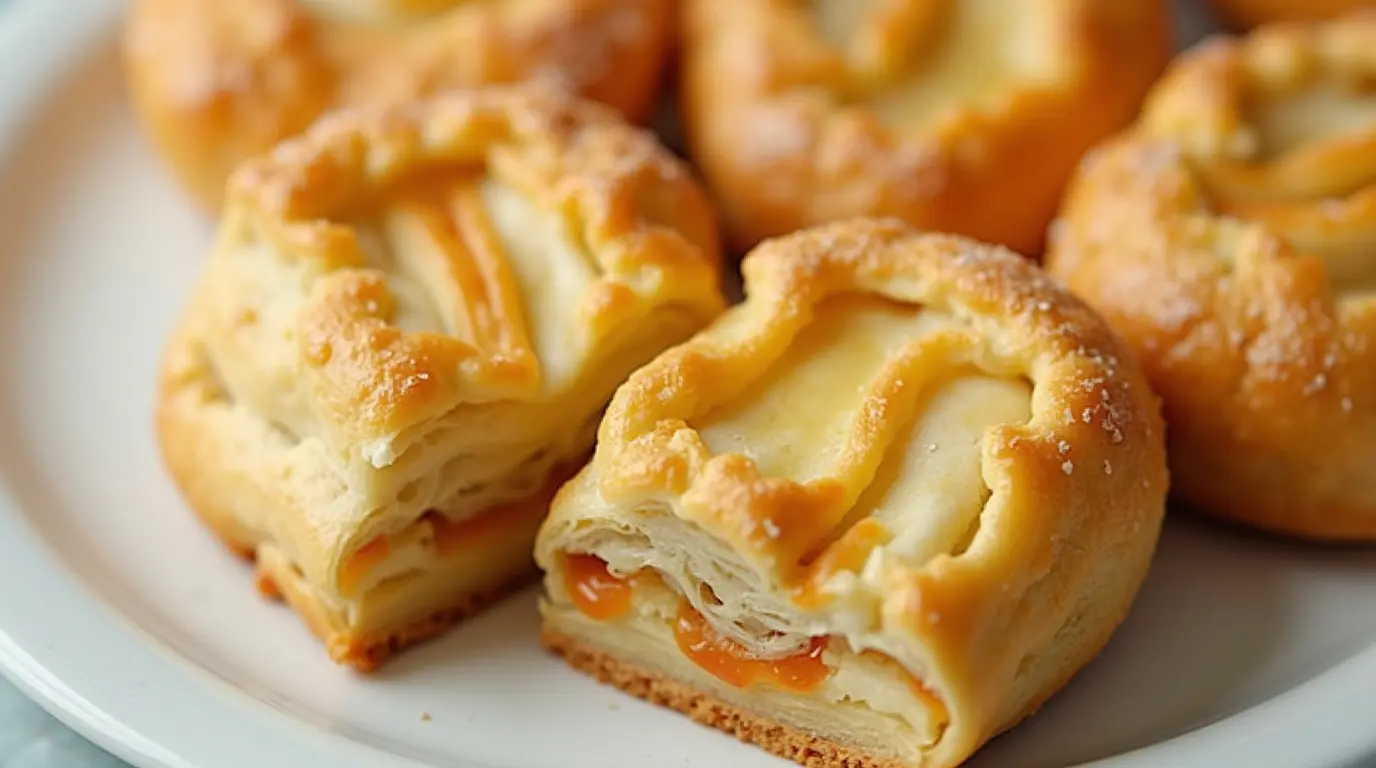Puff pastry is pure magic, crisp, golden layers that turn simple ingredients into bakery-worthy desserts.
Whether you’re folding it with fruit, stacking it with cream, or twisting it into something totally new, these flaky treats bring elegance without effort.
Table of contents
Popular Puff Pastry Desserts to Try
Now that we’ve uncovered what puff pastry is, let’s explore the sweet side of this versatile dough. From elegant French classics to quick and easy snacks, there’s something for everyone.
Classic French Pastries: Croissants and Napoleons
When it comes to puff pastry, the French reign supreme. Croissants, with their golden crust and soft interior, are perhaps the most iconic puff pastry . Then there’s the Napoleon, also known as mille-feuille a heavenly dessert made of layered pastry sheets and creamy fillings. These desserts aren’t just tasty; they’re pieces of edible art.
Sweet Tarts: Fruit, Custard, and Beyond
Fruit tarts are another crowd-pleaser. Picture this: a crispy puff pastry base topped with velvety custard and fresh berries. It’s the perfect balance of textures and flavors. You can get creative with toppings apples, peaches, or even a drizzle of chocolate.
Puff Pastry vs. Phyllo Dough in Dessert Making
This brings us to a common question: can you use phyllo dough in place of puff pastry for desserts? While both are flaky, they’re not quite the same (we’ll dive into this later). For now, stick with puff pastry for buttery, rich treats, and save phyllo for delicate, crispy bites like baklava.
Is Phyllo Dough the Same as Puff Pastry?
This is one of the most frequently asked questions in the baking world. On the surface, phyllo dough and puff pastry look similar. They’re both thin, layered, and versatile. But dig deeper, and you’ll see they’re as different as chalk and cheese.

The Differences in Ingredients and Preparation
Puff pastry is made with butter layered into the dough, creating a rich, flaky texture. Phyllo, on the other hand, uses oil and water, resulting in a paper-thin sheet. Phyllo requires careful handling it’s so thin it’s almost transparent! Puff pastry is forgiving and robust, making it easier for beginners to handle.
When to Use Each in Recipes
- Use Puff Pastry For: Cream-filled desserts, tarts, and turnovers.
- Use Phyllo Dough For: Strudels, baklava, and savory pies like spanakopita.
Common Mistakes When Using Puff Pastry or Phyllo Dough
- Puff Pastry Mistake: Not keeping it cold. Warm dough loses its structure, resulting in a soggy mess.
- Phyllo Dough Mistake: Letting it dry out. Always cover phyllo with a damp cloth while working.
How to Make Perfect Puff Pastry at Home
Making puff pastry from scratch might seem intimidating, but it’s incredibly rewarding. Sure, it takes some time and patience, but the results are well worth it. Plus, you’ll feel like a pro baker when you pull off those perfectly flaky layers. Let’s break it down step by step.
Step-by-Step Guide to Making Puff Pastry Dough
- Start with the Dough (Détrempe):
Combine all-purpose flour, a pinch of salt, and cold water to form a basic dough. You want it to be firm yet pliable, so adjust the water as needed. Chill the dough for at least 30 minutes to relax the gluten. - Prepare the Butter Block (Beurrage):
Use high-quality, unsalted butter. Shape it into a flat rectangle by placing it between two sheets of parchment paper and rolling it out. The butter should be cold but not so hard that it breaks when folded into the dough. - Encasing the Butter:
Roll out your chilled dough into a larger rectangle. Place the butter block in the center, fold the dough over it like an envelope, and seal the edges. - Lamination Begins:
Roll out the dough-butter package into a long rectangle. Fold it into thirds, like folding a letter. This is your first “turn.” Chill the dough for 30 minutes before repeating the process. - Repeat and Chill:
Most puff pastry recipes call for 5–6 turns, with a rest period in the refrigerator between each turn. This ensures the butter stays cold and the layers remain distinct. - Final Rolling:
Roll the pastry to your desired thickness and shape before using it in recipes. Remember, the thinner the pastry, the flakier the layers.
Craving more no-fuss dessert ideas? Dive into our quick & easy recipes for treats that impress with minimal effort.
Time-Saving Tips for Beginners
- Use a Pastry Cutter or Bench Scraper: It helps keep the edges clean during folding.
- Keep Everything Cold: Warm butter melts and ruins the layers, so work quickly and chill often.
- Skip the Stress: If homemade puff pastry feels like too much, buy a high-quality store-bought version. It’s perfectly fine for most recipes.
Common Problems and How to Solve Them
- Problem: Dough Sticking to the Surface
- Solution: Dust your work surface lightly with flour, but don’t overdo it excess flour can dry out the dough.
- Problem: Uneven Layers
- Solution: Roll with consistent pressure and rotate the dough frequently to maintain even thickness.
- Problem: Butter Leaking Out During Baking
- Solution: This often happens if the butter wasn’t cold enough or if the dough wasn’t sealed properly. Always chill the dough between turns and double-check seals.
Puff Pastry Dessert Recipe Ideas
Once you’ve got your puff pastry ready, it’s time to put it to good use. These recipes range from beginner-friendly to advanced, so there’s something for everyone.
Chocolate-Filled Puff Pastry Twists
Ingredients:
- Puff pastry sheet
- Dark chocolate or chocolate chips
- Egg wash
Instructions:
- Preheat your oven to 375°F (190°C).
- Roll out a puff pastry sheet and cut it into long strips.
- Place pieces of chocolate along the center of each strip.
- Fold the strip over and twist it a few times.
- Brush with egg wash for a golden finish and bake for 12–15 minutes.
The result? Gooey chocolate encased in crispy, buttery pastry a dessert that’s as easy as it is indulgent.
Fruit-Filled Turnovers
Ingredients:
- Puff pastry squares
- Fruit filling (apple, cherry, or peach)
- Sugar for sprinkling
Instructions:
- Spoon a small amount of fruit filling onto the center of a pastry square.
- Fold the square into a triangle and seal the edges with a fork.
- Brush with egg wash and sprinkle with sugar.
- Bake at 375°F (190°C) for about 20 minutes, until golden brown.
These turnovers are portable, delicious, and perfect for any occasion.
Puff Pastry Mille-Feuille
Ingredients:
- Pre-baked puff pastry sheets
- Pastry cream
- Powdered sugar
Instructions:
- Layer puff pastry sheets with generous amounts of pastry cream.
- Repeat until you have three layers, finishing with a pastry sheet.
- Dust with powdered sugar or drizzle with glaze.
This elegant dessert looks like it came straight from a Parisian bakery but is surprisingly simple to make.
Looking for more timeless, homemade-style desserts? Explore our Grandma’s recipes, classic comfort bakes that never go out of style.
Frequently Asked Questions (FAQs)
Can I use frozen puff pastry for desserts?
Yes! Store-bought frozen puff pastry works perfectly. Just thaw it in the fridge before using, and keep it cold until baking for the best rise.
Why is my puff pastry not flaky?
Flakiness depends on cold butter and hot oven. If the dough warms up too much before baking or your oven isn’t preheated, layers may collapse.
Can I make puff pastry desserts ahead of time?
You can prep and shape them ahead, but bake just before serving for max crispiness. Baked puff pastry softens if stored too long.
What fillings work best in puff pastry desserts?
Fruit preserves, pastry cream, Nutella, whipped cream, and even cream cheese blends all pair beautifully with puff pastry’s light texture.

